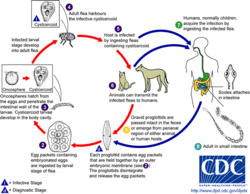Dipylidium caninum
Dipylidium caninum, also called the flea tapeworm, double-pored tapeworm, or cucumber tapeworm (in reference to the shape of its cucumber-seed-like proglottids, though these also resemble grains of rice or sesame seeds), is a cyclophyllid cestode that infects organisms afflicted with fleas and canine chewing lice, including dogs, cats, and sometimes human pet-owners, especially children.
| Dipylidium caninum | |
|---|---|
| Adult Dipylidium caninum. The scolex of the worm is very narrow and the proglottids get larger as they mature | |
| Scientific classification | |
| Kingdom: | Animalia |
| Phylum: | Platyhelminthes |
| Class: | Cestoda |
| Order: | Cyclophyllidea |
| Family: | Dipylidiidae |
| Genus: | Dipylidium |
| Species: | D. caninum |
| Binomial name | |
| Dipylidium caninum (Linnaeus, 1758) | |

Adult morphology
The adult worm is about 18 inches (46 cm) long. Gravid proglottids containing the worm's microscopic eggs are either passed in the definitive host's feces or may leave their host spontaneously and are then ingested by microscopic flea larvae (the intermediate hosts) in the surrounding environment. As in all members of family Dipylidiidae, proglottids of the adult worm have genital pores on both sides (hence the name double-pore tapeworm). Each side has a set of male and female reproductive organs. The uterus is paired with 16 to 20 radial branches each. The scolex has a retractable rostellum with four rows of hooks, along with the four suckers that all cyclophyllid cestodes have.
Life cycle
The definitive host within this lifecycle is primarily canines, and occasionally felines, and in rare cases young children. The intermediate hosts include fleas (Ctenocephalides spp.) and chewing lice. The first stage in the lifecycle is when the gravid proglottids are either passed out through fecal matter, or actively crawl out of the anus of the host. The gravid proglottids once out of the definitive host release eggs. Then, an intermediate host will ingest an egg, which develops into a cysticercoid larva. The adult flea or louse will then harbor the infective cysticercoid until a definitive host, such as a dog, becomes infected by ingesting an infected flea or louse while grooming themselves. Humans can also become infected by D. caninum by accidentally ingesting an infected flea. In the small intestine of the definitive host, the cysticercoid develops into an adult tapeworm, which reaches maturity about one month after infection. This adult tapeworm produces proglottids, and over time, the proglottids mature and become gravid and eventually detach from the tapeworm and the lifecycle starts all over again.[1]
Pet infections
Tapeworm infection usually does not cause pathology in the dog or cat, and most pets show no adverse reaction to infection other than increased appetite. The other tapeworm infecting cats is Taenia taeniaeformis, though this form is much less commonly encountered than D. caninum.
A recent (2018) study using genetical analysis and experimental infections and life-cycles showed that two different distinct genotypes of D. caninum occur respectively in dogs and in cats, and suggested that two different species might be involved.[2] [3]
Human infections
A human infection with D. caninum is rare, but if an infection does occur, it is more likely to occur in young children. Only 16 cases have been reported of D. caninum infections in humans within the last 20 years, and almost all of the cases were found in children. Young children and toddlers are at a greater risk of infection because of how they interact with their pets. A human may attain an infection by accidentally ingesting an infected flea through food contamination or through the saliva of pets. Most infections are asymptomatic, but sometimes these symptoms may be identified in an infected individual: mild diarrhea, abdominal colic, anorexia, restlessness, constipation, rectal itching, and pain due to emerging proglottids through the anal cavity.[4]
Treatment and prevention
As with most tapeworm infections, the drugs of choice are niclosamide or praziquantel. The best way to prevent human infection is to treat infected animals with products which aid in killing the fleas on the animal. One can also use oral medication prescribed by a veterinarian.
Gallery
- Dipylidium caninum egg packet
- D. caninum proglottid
 D. caninum
D. caninum- D. caninum worms
References
- "Dipylidium caninum Infection". Centers for Disease Control and Prevention. Retrieved 24 April 2015.
- Labuschagne, Michel; Beugnet, Frédéric; Rehbein, Steffen; Guillot, Jacques; Fourie, Josephus; Crafford, Dionne (2018). "Analysis of Dipylidium caninum tapeworms from dogs and cats, or their respective fleas. Part 1. Molecular characterization of Dipylidium caninum: genetic analysis supporting two distinct species adapted to dogs and cats". Parasite. 25: 30. doi:10.1051/parasite/2018028. PMC 6013089. PMID 29806592.

- Beugnet, Frédéric; Labuschagne, Michel; Vos, Christa de; Crafford, Dionne; Fourie, Josephus (2018). "Analysis of Dipylidium caninum tapeworms from dogs and cats, or their respective fleas. Part 2. Distinct canine and feline host association with two different Dipylidium caninum genotypes". Parasite. 25: 31. doi:10.1051/parasite/2018029. PMC 6013090. PMID 29806593.

- Garcia-Martos, Pedro; Garcia-Agudo, Lidia; Rodriguez-Iglesias, Manuel (26 May 2014). "Dipylidium caninum infection in an infant: a rare case report and literature review" (PDF). Asian Pacific Journal of Tropical Biomedicine. 4 (2): S565–S567. Archived from the original on 18 May 2015. Retrieved 20 September 2016.CS1 maint: BOT: original-url status unknown (link)